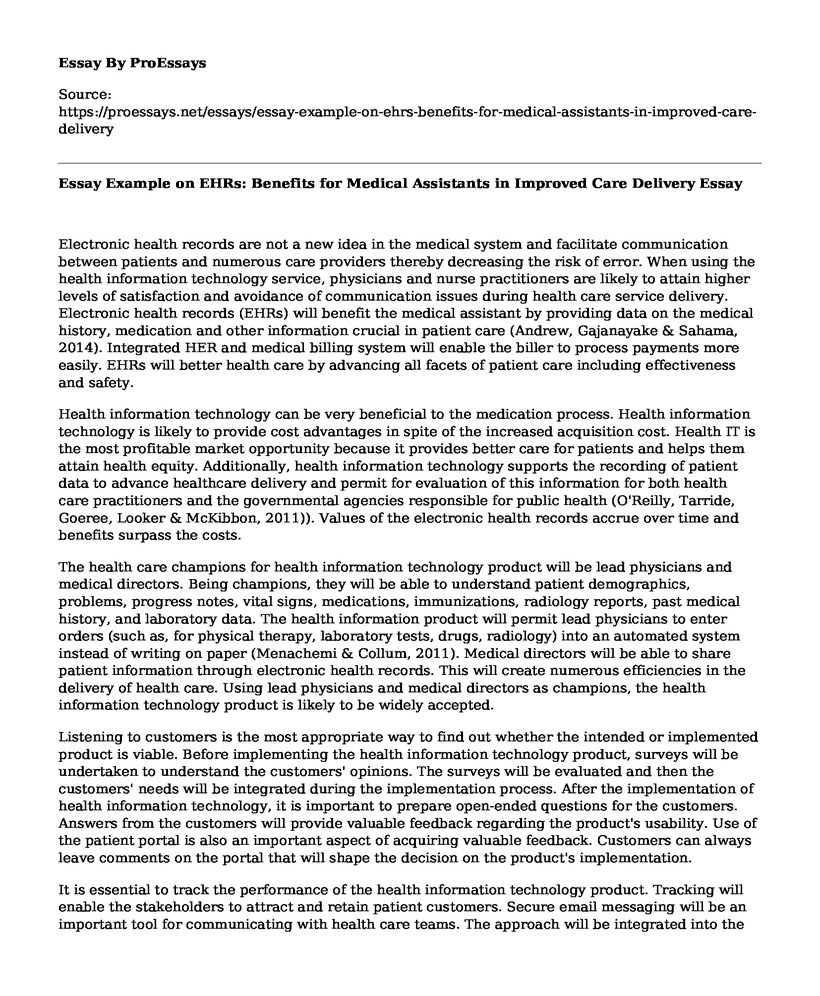Electronic health records are not a new idea in the medical system and facilitate communication between patients and numerous care providers thereby decreasing the risk of error. When using the health information technology service, physicians and nurse practitioners are likely to attain higher levels of satisfaction and avoidance of communication issues during health care service delivery. Electronic health records (EHRs) will benefit the medical assistant by providing data on the medical history, medication and other information crucial in patient care (Andrew, Gajanayake & Sahama, 2014). Integrated HER and medical billing system will enable the biller to process payments more easily. EHRs will better health care by advancing all facets of patient care including effectiveness and safety.
Health information technology can be very beneficial to the medication process. Health information technology is likely to provide cost advantages in spite of the increased acquisition cost. Health IT is the most profitable market opportunity because it provides better care for patients and helps them attain health equity. Additionally, health information technology supports the recording of patient data to advance healthcare delivery and permit for evaluation of this information for both health care practitioners and the governmental agencies responsible for public health (O'Reilly, Tarride, Goeree, Looker & McKibbon, 2011)). Values of the electronic health records accrue over time and benefits surpass the costs.
The health care champions for health information technology product will be lead physicians and medical directors. Being champions, they will be able to understand patient demographics, problems, progress notes, vital signs, medications, immunizations, radiology reports, past medical history, and laboratory data. The health information product will permit lead physicians to enter orders (such as, for physical therapy, laboratory tests, drugs, radiology) into an automated system instead of writing on paper (Menachemi & Collum, 2011). Medical directors will be able to share patient information through electronic health records. This will create numerous efficiencies in the delivery of health care. Using lead physicians and medical directors as champions, the health information technology product is likely to be widely accepted.
Listening to customers is the most appropriate way to find out whether the intended or implemented product is viable. Before implementing the health information technology product, surveys will be undertaken to understand the customers' opinions. The surveys will be evaluated and then the customers' needs will be integrated during the implementation process. After the implementation of health information technology, it is important to prepare open-ended questions for the customers. Answers from the customers will provide valuable feedback regarding the product's usability. Use of the patient portal is also an important aspect of acquiring valuable feedback. Customers can always leave comments on the portal that will shape the decision on the product's implementation.
It is essential to track the performance of the health information technology product. Tracking will enable the stakeholders to attract and retain patient customers. Secure email messaging will be an important tool for communicating with health care teams. The approach will be integrated into the web-based patient portals to allow easy and secure communication. Tracking will also involve assessing the interaction processes between health care teams and patients. Any positive or negative feedback will always be taken as progress after implementation (Haun, Patel, Lind & Antinori, 2015). Secure email messaging will enable customers to engage with health care teams and also allow them to effectively use health services. The platform will also allow self-care management.
References
Andrews, L., Gajanayake, R., & Sahama, T. (2014). The Australian general public's perceptions of having a personally controlled electronic health record (PCEHR). International Journal of Medical Informatics, 83(12), 889-900.
Haun, J. N., Patel, N. R., Lind, J. D., & Antinori, N. (2015). Large-scale survey findings inform patients' experiences in using secure messaging to engage in patient-provider communication and self-care management: a quantitative assessment. Journal of medical Internet research, 17(12), e282.
Menachemi, N., & Collum, T. H. (2011). Benefits and drawbacks of electronic health record systems. Risk management and healthcare policy, 4, 47.
O'Reilly, D., Tarride, J. E., Goeree, R., Lokker, C., & McKibbon, K. A. (2011). The economics of health information technology in medication management: a systematic review of economic evaluations. Journal of the American Medical Informatics Association, 19(3), 423-438.
Cite this page
Essay Example on EHRs: Benefits for Medical Assistants in Improved Care Delivery. (2022, Dec 27). Retrieved from https://proessays.net/essays/essay-example-on-ehrs-benefits-for-medical-assistants-in-improved-care-delivery
If you are the original author of this essay and no longer wish to have it published on the ProEssays website, please click below to request its removal:
- Essay Sample on Cerebrovascular & Coronary Artery Disease: Causes & Effects
- Essay Example on Racial Disparities in Diabetes Prevention & Care: Double the Risk for Hispanics & African-Americans
- Hippocampal Neurogenesis: Regulation of Cognitive & Psychiatric Diseases - Essay Sample
- Essay Sample on Unifying Business with Cloud and Virtualization Tech
- Paper Example on Nurses Step Up: Playing an Active Role in Passing Laws
- Essay Example on 49yo Lung Cancer Patient Seeking Relief: Exploring Medical Marijuana
- Paper on Analyzing Resuscitation Plans in End-of-Life Decisions: Considerations for Future Healthcare Practices







